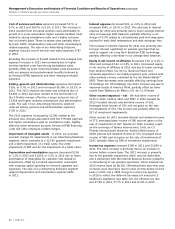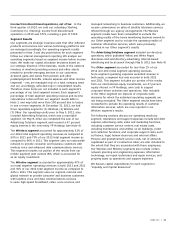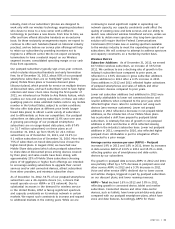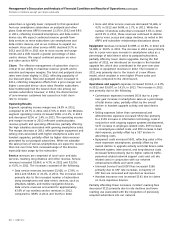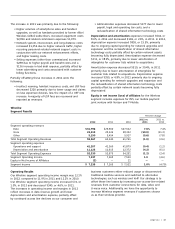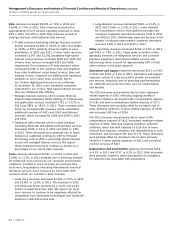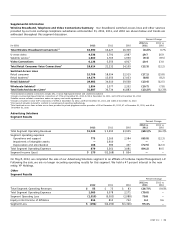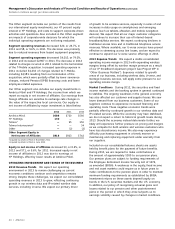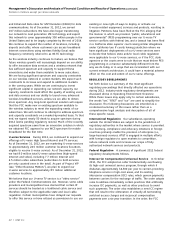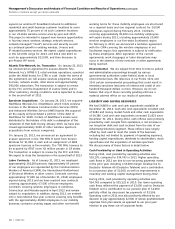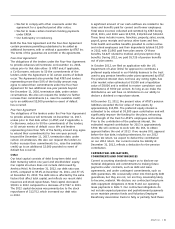AT&T Wireless 2012 Annual Report Download - page 44
Download and view the complete annual report
Please find page 44 of the 2012 AT&T Wireless annual report below. You can navigate through the pages in the report by either clicking on the pages listed below, or by using the keyword search tool below to find specific information within the annual report.
Management’s Discussion and Analysis of Financial Condition and Results of Operations (continued)
Dollars in millions except per share amounts
42 | AT&T Inc.
existing or new right-of-ways to deploy or activate our
U-verse-related equipment, services and products, resulting in
litigation. Petitions have been filed at the FCC alleging that
the manner in which we provision “public, educational and
governmental” (PEG) programming over our U-verse TV
service conflicts with federal law, and a lawsuit has been filed
in a California state superior court raising similar allegations
under California law. If courts having jurisdiction where we
have significant deployments of our U-verse services were
to decide that federal, state and/or local cable regulation
were applicable to our U-verse services, or if the FCC, state
agencies or the courts were to rule that we must deliver PEG
programming in a manner substantially different from the
way we do today or in ways that are inconsistent with our
current network architecture, it could have a material adverse
effect on the cost and extent of our U-verse offerings.
REGULATORY DEVELOPMENTS
Set forth below is a summary of the most significant
regulatory proceedings that directly affected our operations
during 2012. Industry-wide regulatory developments are
discussed above in Operating Environment Overview.
While these issues may apply only to certain subsidiaries,
the words “we,” “AT&T” and “our” are used to simplify the
discussion. The following discussions are intended as a
condensed summary of the issues rather than as a
comprehensive legal analysis and description of all of
these specific issues.
International Regulation Our subsidiaries operating
outside the United States are subject to the jurisdiction of
regulatory authorities in the market where service is provided.
Our licensing, compliance and advocacy initiatives in foreign
countries primarily enable the provision of enterprise (i.e.,
large-business) services. AT&T is engaged in multiple efforts
with foreign regulators to open markets to competition,
reduce network costs and increase our scope of fully
authorized network services and products.
Federal Regulation A summary of significant 2012 federal
regulatory developments follows.
Intercarrier Compensation/Universal Service In October
2011, the FCC adopted an order fundamentally overhauling
its high-cost universal service program, through which it
disburses approximately $4,500 per year to carriers providing
telephone service in high-cost areas, and its existing
intercarrier compensation (ICC) rules, which govern payments
between carriers for the exchange of traffic. The order adopts
rules to address immediately certain practices that artificially
increase ICC payments, as well as other practices to avoid
such payments. The order also establishes a new ICC regime
that will result in the elimination of virtually all terminating
switched access charges and reciprocal compensation
payments over a six-year transition. In the order, the FCC
and Enhanced Data rates for GSM Evolution (EDGE) for data
communications. As of December 31, 2012, we served
107 million subscribers. We have also begun transitioning
our network to next generation LTE technology and expect
this network to cover approximately 300 million people in the
United States and to be largely complete by the end of 2014.
We continue to expand the number of locations, including
airports and cafés, where customers can access broadband
Internet connections using wireless fidelity (local radio
frequency commonly referred to as Wi-Fi) technology.
As the wireless industry continues to mature, we believe that
future wireless growth will increasingly depend on our ability
to offer innovative data services and a wireless network that
has sufficient spectrum and capacity to support these
innovations and make them available to more subscribers.
We are facing significant spectrum and capacity constraints
on our wireless network in certain markets. We expect such
constraints to increase and expand to additional markets
in the coming years. While we are continuing to invest
significant capital in expanding our network capacity, our
capacity constraints could affect the quality of existing voice
and data services and our ability to launch new, advanced
wireless broadband services, unless we are able to obtain
more spectrum. Any long-term spectrum solution will require
that the FCC make new or existing spectrum available to
the wireless industry to meet the expanding needs of our
subscribers. We will continue to attempt to address spectrum
and capacity constraints on a market-by-market basis. To that
end, we signed nearly 50 deals to acquire spectrum during
2012 (some pending regulatory review). Much of the recently
acquired spectrum came from an innovative solution in which
we obtained FCC approval to use WCS spectrum for mobile
broadband for the first time.
U-verse Services During 2012, we continued to expand our
offerings of U-verse High Speed Internet and TV services.
As of December 31, 2012, we are marketing U-verse services
to approximately 24.5 million customer locations (locations
eligible to receive U-verse service). As of December 31, 2012,
we had 8.0 million total U-verse subscribers (high-speed
Internet and video), including 7.7 million Internet and
4.5 million video subscribers (subscribers to both services
are only counted once in the total). As part of Project VIP
(see “Other Business Matters”), we plan to expand our
U-verse services to approximately 8.5 million additional
customer locations.
We believe that our U-verse TV service is a “video service”
under the Federal Communications Act. However, some cable
providers and municipalities have claimed that certain IP
services should be treated as a traditional cable service and
therefore subject to the applicable state and local cable
regulation. Certain municipalities have delayed our requests
to offer this service or have refused us permission to use our


